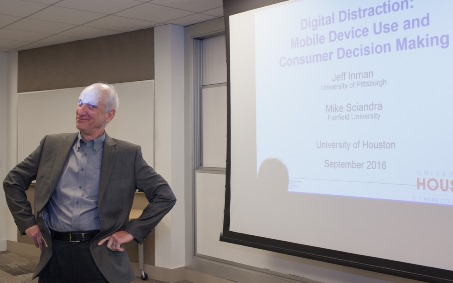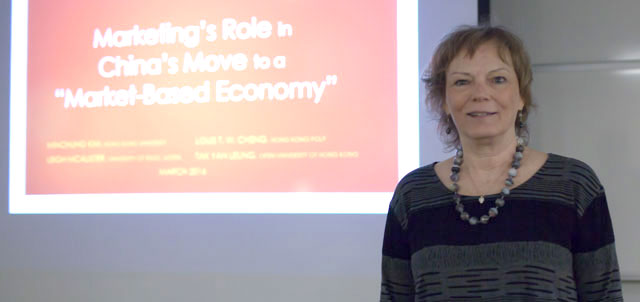|
Date
|
Speaker
|
Topic
|
Faculty Host
|
11/18/2016
365A MH
10:30-12:00
|
Mitch Lovett
Rochester
|
Private Labels and Retailer Profitability: Bilateral Bargaining in the Grocery Channel
-
Click to read Abstract
We examine the role of store branded (private label) products in determining the bargaining outcomes between retailers and manufacturers in the brew-at-home coffee category. Exploiting a novel setting in which the dominant, single-serve technology was protected by a patent preventing private label entry, we develop a structural model of demand and supply-side bargaining and seek to quantify the impact of private labels on bargaining outcomes. We find that, while bargaining parameters are relatively symmetric across retailers and manufacturers, the addition of private labels alters bargaining outcomes by improving the disagreement payoffs of the retailers (relative to the manufacturers), thereby shifting bargaining outcomes in the retailer's favor.
|
Kitty Wang
|
11/11/2016
365A MH
10:30-12:00
|
Rosellina Ferraro
Maryland
|
When the Face of Need Backfires: The Impact of Facial Emotional Expression on the Effectiveness of Cause-Related Marketing Advertisements
-
Click to read Abstract
Cause-related marketing (CM) has been one of the fastest-growing category of corporate sponsorship spending in the United States, with average annual growth rates of greater than 12% (IEG 2009). In CM campaigns, companies link the purchase of their product to support charitable causes. As part of these campaigns, companies often display the image of a victim suffering from the condition or circumstances (e.g., a starving child, a patient suffering from cancer) in their promotional materials. The images used may vary in terms of the victim’s facial emotional expression, including sadness and happiness. This raises the question of whether specific emotional depictions may affect the impact of the promotional materials. Research on faced-based judgments has shown that facial expressions that convey emotion elicit vicarious emotion in observers an effect called emotional contagion. The emotional contagion effect has been demonstrated in the non-profit charitable advertisement context, such that when consumers viewed a charitable advertisement which features the image of a victim experiencing a specific emotion, consumers experienced the same emotion (Small and Verrochi 2009). That is, a happy-faced victim elicited happiness in viewers and a sad-faced victim elicited sadness in viewers. The elicited sadness increased empathy toward the victim and subsequently increased donations. The current research asks whether the same emotional contagion and subsequent changes in empathy will be triggered by the image of a victim experiencing a specific emotion in CM advertisements by for-profit organizations. We propose and show that the image of a victim depicting sadness will evoke a different psychological process in CM advertisements than it does for charity-based advertisements. We demonstrate that consumers perceive the image of a sad-faced victim (vs. happy-faced victim) in CM advertisements as designed to manipulate emotion to sell a product, which in turn reduces the effectiveness of CM advertisements. To further support the perceived manipulativeness mechanism, we test a moderating variable specifically, whether the cause or the product is centrally presented. We show that the negative effect of a sad-faced (vs. happy-faced) victim on the effectiveness of CM advertisements is attenuated in the product-focused advertisements, which are perceived as less manipulative.
|
Kitty Wang
|

|
11/4/2016
365A MH
10:30-12:00
|
Raghu Bommaraju
UH
|
The Impact Of Mergers and Acquisitions on the Sales Force
-
Click to read Abstract
Most research into mergers and acquisitions (M&As) focuses on shareholder outcomes. This article takes a novel approach by evaluating the effect of M&As on the firm’s internal stakeholders, namely, the sales force. In particular, mergers that harm the organization’s image might hinder salespeople’s organizational identification (OI), so the authors use longitudinal data from a natural experiment to test the causal effect of a merger on the OI of salespeople employed by the acquiring firm. The analysis reveals that their OI decreases after the merger, resulting in poorer selling performance. Salespeople’s tenure intensifies these effects social inclusion dampens them. Although managers’ active efforts to build OI generally improve salespeople’s OI, these activities have differential effects during an M&A. When managers communicate the organization’s strategic direction, it shields salespeople from some of the detrimental effects of the merger. In contrast, when managers emphasize the culture or distinctiveness of the organization, it exacerbates the damage to salespeople’s OI.
|
|

|
10/14/2016
365A MH
10:30-12:00
|
Sanjay Jain
UT Dallas
|
Pricing and Product Design for Vice Goods: A Strategic Analysis
-
Click to read Abstract
The rising obesity epidemic is a worldwide concern for consumers, firms, and policy makers. One reason for the rise in obesity is consumers'''' over-consumption of vice goods such as cookies, crackers, and soft drinks. Some authors have suggested that firms have insufficient incentives to make products healthier and to reduce over-consumption. There are calls for regulations to ensure that firms make products healthier and provide nutritional information that help consumers make healthy food choices. Furthermore, public policy makers have begun to educate consumers to avoid over-consumption by using strategies such as pre-purchase planning. In this paper, we investigate how firms selling vice goods should respond to the growing concerns about obesity. We analyze how firms should adjust prices and product healthiness to cater to consumers with self-control problems and obesity concerns. We use the literature on hyperbolic discounting to model consumers with self-control problems. In this framework, we examine how the healthiness of vice goods affects prices, firm''''s profits, consumer surplus, and public health. In addition, we study how public policy efforts to encourage pre-purchase planning impact firm''''s profits and consumers. Our results show that unlike standard goods, for vice goods a decrease in quality (i.e., unhealthiness) and an increase in price can serve as a self-control device and increase demand. Therefore, firms sometimes can charge higher prices and make more profits by producing unhealthier products. Interestingly, producing unhealthier products can sometimes increase consumer surplus and improve public health. We also show that as the proportion of consumers who use pre-purchase planning increases, firms should respond by raising prices. In such situations, consumer surplus and public health improve but firm''''s profits decline. These results have important implications for restaurants and firms that sell vice goods and for public policy makers who aim to combat obesity.
|
Ye Hu
|

|
9/30/2016
365A MH
10:30-12:00
|
Rajdeep Grewal
UNC-Chapel Hill
|
Intellectual Capital and New Drug Pricing
-
Click to read Abstract
The authors focus on the effect of intellectual capital of prescription drugs on the drugs' launch prices. With data on 365 new prescription drug launches between 1984 and 2003 in 38 different therapeutic product categories, the authors conceptualize intellectual capital for the drugs as the effective patent life (measured as the remaining exclusivity period of the patent before expiry) and the strength of the patent portfolio (assessed as the number of patents attached to the molecules of the drug). Building on the extant empirical literature on pharma pricing that focuses largely on competition and quality measures of the drug as the key determinants of launch pricing, the authors develop a hedonic pricing model that investigates the impact of intellectual capital as – (1) consumer utility bearing characteristic to influence demand and (2) as a market power tool to garner monopoly rents. The findings suggest that at the launch stage, the intellectual capital influences pricing as consumer utility bearing characteristic and not at a market power tool. Much against the conventional wisdom regarding intellectual capital and drug pricing, a drug’s ability to charge premium price at the launch stage compared to the other prescription drug substitutes is significantly influenced by the order of its entry in the category and not by intellectual capital. Authors also examine the moderating effect of promotion spending and manufacturer’s innovation strength in the category for the impact of intellectual capital on launch pricing. Higher the direct to consumer advertising (focused towards market expansion) lower is the launch price of drug and intellectual capital elasticity of launch price. Higher the detailing to physicians (focused towards increasing market share) higher is the launch price and intellectual capital elasticity of launch price. Regarding the innovation strength of the manufacturer, higher innovation strength of a manufacturer is associated with higher launch price of a new drug by the same manufacturer in the category and lower intellectual capital elasticity of launch price.
|
Ye Hu
|

|
9/23/2016
365A MH
10:30-12:00
|
Jeff Inman
Pitt
|
Digital Distraction: Consumer Mobile Device Use and Decision Making
-
Click to read Abstract
The rapid growth of mobile devices has provided firms with an unprecedented opportunity to engage consumers. However, firms are struggling to adapt to and understand the impact of mobile devices on consumer outcomes. One common but understudied area is the role that mobile devices play in consumer decisions. Building upon prior research investigating consumer technology use during decision situations, the authors classify mobile device use into two defining categories (task-related and task-unrelated) and examine the impact these differing usage types have on consumer decision quality. Across an in-store field study and two experiments, the authors demonstrate that depending on use, mobile devices can act as a double-edged sword with either positive or negative implications for consumers and marketers. The authors find support for their predictions that task-unrelated mobile device use degrades consumer decision making and is associated with an increase in unplanned purchasing, forgetting planned items, and a reliance on heuristics during the decision making process. Conversely, task-related mobile device use can help consumers make better decisions, including purchasing fewer unplanned items and selecting more efficient alternatives. Implications for research and practice are discussed.
|
Sam Hui
|

|
9/16/2016
365A MH
10:30-12:00
|
Neil Morgan
Indiana
|
When and How Does Market Share Drive Profits?
-
Click to read Abstract
Most managers believe that market share is valuable and many firms use it to both set goals and assess marketing performance. Market share is also one of the most widely used dependent variables in studies of the performance impact of marketing. Yet, the existence, scale, and nature of any economic performance impact of firms’ market share remains unclear. In fact, while many managers assume a positive relationship between market share and firm profit, the past empirical literature has mostly indicated a non-significant relationship—with indications that the relationship can even be negative. In this study we examine the market share-economic performance relationship over a long time period in a large sample of U.S. markets using both different measures of market share and a number of different econometric analysis approaches. We show that market share is both an indicator of product-market performance in the marketing-performance outcome with ''chain'' and also a valuable market-based asset. In addition, we find that market share’s relationship with market power and quality signaling explain most of the variance. We also find that counter to assumptions in economic theory, the value of market share is contingent on the business strategy the firm adopts and the firm’s marketing capability.
|
Sam Hui
|

|
4/15/2016
365A MH
10:30-12:00
|
Cait Lamberton
Pitt
|
Men and the Middle: Understanding Context Effects in Dyads
-
Click to read Abstract
The compromise effect has been shown to be robust among individual decision-makers. But what happens when consumers make these choices with someone else? In the present paper, we explore compromise effects in joint decision contexts. Findings reveal that the compromise effect replicates in mixed-gender and female-female dyads, but is attenuated when two males make a choice together. Furthermore, when males make joint decisions, their tendency to choose a compromise option decreases not only relative to other pairs but also to individual decision-makers. The authors argue that this happens because dyadic contexts lead to reliance on social norms as a primary decision determinant. Because men believe that expressing a preference for the compromise option in front of another man is non-normative, male-male dyads do not exhibit the compromise effect. Support for this mechanism is provided in two studies showing that (1) males are judged more harshly by males when they exhibit preference for the compromise option in the presence of a male but not a female and (2) we can generate compromise effects when male-male dyads engage in double-blinded joint decision-making, which involves no preference sharing. These findings have important implications for theory, consumer well-being, and marketing strategies.
|
|

|
4/1/2016
365A MH
10:30-12:00
|
Seshadri Tirunillai
UH
|
How Governance Structure Affects Customer Engagement in Social Media? Findings from a Randomized Controlled Online Experiment
|
|

|
3/25/2016
365A MH
10:30-12:00
|
Shyam Gopinath
Utah
|
Preaching to the Choir: The Chasm Between Top Ranked Reviewers, Mainstream Opinion, and Product Sales
-
Click to read Abstract
Online opinion leaders have a role to play in disseminating information and driving product sales. In this research we investigate the differential impact of top ranked reviewers and bottom ranked reviewers on both product sales and the review valence generation process. We use a panel data based on all reviews and product sales information covering the first two months of release for 182 new music albums on Amazon.com. From the model estimation we find that the impact of reviews by the two groups on sales varies by product type (mainstream vs. niche) and by the variance of reviews for the product. Top ranked reviewers are comparatively more influential for mainstream product releases and for products that lack a strong consensus among existing reviews. In contrast, non-highly-ranked reviewers are relatively more influential for niche products and for products with low review variance. The findings of the study are in-line with theory based on reviewer similarity (homophily). Overall, we find that top ranked reviewers act as opinion leaders for newly released products, but their influence is largely limited to other top ranked reviewers as evidenced by subsequent reviews. In contrast, the reviews of non-highly- ranked reviewers have a far greater influence on the opinions of other non-highly-ranked reviewers and on product sales.
|
|

|
3/11/2016
365A MH
10:30-12:00
|
Leigh McAlister
UT Austin
|
Marketing's Role in China's Move to a "Market-Based Economy"
|
|

|
2/12/2016
365A MH
10:30-12:00
|
Michael Trusov
Maryland
|
The Path to Click – Are You On It?
-
Click to read Abstract
The authors investigate the information search process that consumers engage in when visually inspecting search engine result pages (SERPs). Eye-tracking data are collected and matched with the textual content of the SERPs (i.e., listings presented on the page). A two-state hidden Markov model of listing inspection choice and gaze duration is developed to capture the latent information processing states during the dynamic inspection process. Consumers switch between two hidden states, namely, the global-exploration state and the local-evaluation state. The impact exerted by section preference, low-level stimuli, and transactional (price, promotion, store) and descriptive (attribute, quality) information differs across states. Two sets of simulations demonstrate the influence of semantic environment on the inspection probabilities of a target listing. The paper offers insights into the content design and optimal target rank selection on SERPs with respect to the content and location of search results from competitors.
|
|

|
2/5/2016
365A MH
10:30-12:00
|
Brent McFerran
Simon Fraser
|
How Can "I" Help "You"?: The Impact of Personal Pronoun Use in Customer-Firm Agent Interactions
-
Click to read Abstract
In responding to customer questions or complaints, should firm agents indeed “put the customer first”? We address this question from a linguistic perspective, focusing on firm agents’ use of personal pronouns (e.g., “I”, “you”, “we”) in customer interactions. Customer-orientation theory suggests that firms will benefit if firm agents emphasize how “you” (the customer) is served by “us” (or “we” the firm) in customer-firm interactions. Lab and field data from over 40 firms demonstrate that firm agents do show this linguistic manifestation of a customer orientation. However, we demonstrate that this recommended pronoun emphasis is not beneficial: we find null effects on customer satisfaction, purchase intentions, and actual purchase volume when firm agents increase their use of “you” and “we” pronouns. Instead, we show positive effects on these variables when firm agents increase their use of “I” pronouns. This effect is robust to multiple covariates and is mediated by customer perceptions of firm agent empathy and agency. These findings offer valuable implications for marketers and enhance our conceptual understanding of how subtle language variations impact consumers.
|
|

|